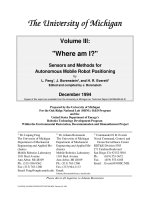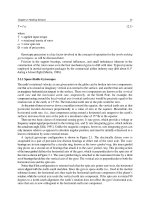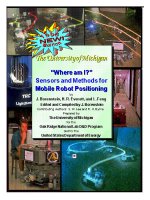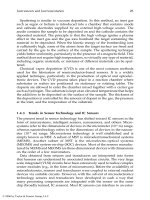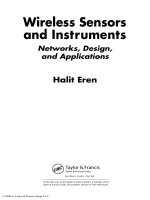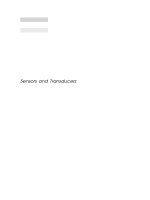Sensors and actuators (1)
Bạn đang xem bản rút gọn của tài liệu. Xem và tải ngay bản đầy đủ của tài liệu tại đây (5.86 MB, 699 trang )
Clarence W. de Silva/Sensors and Actuators: Control Systems Instrumentation 44834_C000 Final Proof
page i 19.12.2006 1:34pm
SENSORS
AND
ACTUATORS
Control Systems
Instrumentation
Clarence W. de Silva/Sensors and Actuators: Control Systems Instrumentation 44834_C000 Final Proof
page ii 19.12.2006 1:34pm
Clarence W. de Silva/Sensors and Actuators: Control Systems Instrumentation 44834_C000 Final Proof page iii
SENSORS
AND
ACTUATORS
Control Systems
Instrumentation
CLARENCE W. de SILVA
Boca Raton London New York
CRC Press is an imprint of the
Taylor & Francis Group, an informa business
19.12.2006 1:34pm
Clarence W. de Silva/Sensors and Actuators: Control Systems Instrumentation 44834_C000 Final Proof page iv 19.12.2006 1:34pm
CRC Press
Taylor & Francis Group
6000 Broken Sound Parkway NW, Suite 300
Boca Raton, FL 33487-2742
© 2007 by Taylor & Francis Group, LLC
CRC Press is an imprint of Taylor & Francis Group, an Informa business
No claim to original U.S. Government works
Printed in the United States of America on acid-free paper
10 9 8 7 6 5 4 3 2 1
International Standard Book Number-10: 1-4200-4483-4 (Hardcover)
International Standard Book Number-13: 978-1-4200-4483-6 (Hardcover)
This book contains information obtained from authentic and highly regarded sources. Reprinted material is quoted
with permission, and sources are indicated. A wide variety of references are listed. Reasonable efforts have been made to
publish reliable data and information, but the author and the publisher cannot assume responsibility for the validity of
all materials or for the consequences of their use.
No part of this book may be reprinted, reproduced, transmitted, or utilized in any form by any electronic, mechanical, or
other means, now known or hereafter invented, including photocopying, microfilming, and recording, or in any information storage or retrieval system, without written permission from the publishers.
For permission to photocopy or use material electronically from this work, please access www.copyright.com (http://
www.copyright.com/) or contact the Copyright Clearance Center, Inc. (CCC) 222 Rosewood Drive, Danvers, MA 01923,
978-750-8400. CCC is a not-for-profit organization that provides licenses and registration for a variety of users. For organizations that have been granted a photocopy license by the CCC, a separate system of payment has been arranged.
Trademark Notice: Product or corporate names may be trademarks or registered trademarks, and are used only for
identification and explanation without intent to infringe.
Library of Congress Cataloging-in-Publication Data
De Silva, Clarence W.
Sensors and actuators : control system instrumentation / Clarence W. de Silva.
p. cm.
“A CRC title.”
Includes bibliographical references and index.
ISBN-13: 978-1-4200-4483-6 (alk. paper)
ISBN-10: 1-4200-4483-4 (alk. paper)
1. Automatic control. 2. Detectors. 3. Actuators. I. Title.
TJ213.D386 2007
670.42’7--dc22
Visit the Taylor & Francis Web site at
and the CRC Press Web site at
2006024039
Clarence W. de Silva/Sensors and Actuators: Control Systems Instrumentation 44834_C000 Final Proof
page v 19.12.2006 1:34pm
Dedication
Dedicated to Charmaine, CJ, and Cheryl, since their ‘‘senses’’ have developed and since they have
become rather ‘‘active.’’
But as artificers do not work with perfect accuracy, it comes to pass that mechanics is so
distinguished from geometry that what is perfectly accurate is called geometrical; what is less
so, is called mechanical. However, the errors are not in the art, but in the artificers.
Sir Isaac Newton, Principia Mathematica,
Cambridge University, May 8, 1686
Clarence W. de Silva/Sensors and Actuators: Control Systems Instrumentation 44834_C000 Final Proof page vi 19.12.2006 1:34pm
Clarence W. de Silva/Sensors and Actuators: Control Systems Instrumentation 44834_C000 Final Proof
page vii 19.12.2006 1:34pm
Preface
This is an introductory book on the subject of control system instrumentation, with an
emphasis on sensors, transducers, and actuators. Specifically, the book deals with ‘‘instrumenting’’ a control system through the incorporation of suitable sensors, actuators, and
associated interface hardware. It will serve as both a textbook for engineering students
and a reference book for practicing professionals. As a textbook, it is suitable for courses
in control system instrumentation; control sensors and actuators; and mechatronics; or
a second course in feedback control systems. The book has adequate material for two
14-week courses, one at the junior (third-year undergraduate) or senior (fourth-year
undergraduate) level and the other at the first-year graduate level. In view of the practical
considerations, design issues, and industrial techniques that are presented throughout the
book, and in view of the simplified and snap-shot style presentation of more advanced
theory and concepts, the book will serve as a useful reference tool for engineers, technicians, project managers, and other practicing professionals in industry and in research
laboratories, in the fields of control engineering, mechanical engineering, electrical and
computer engineering, manufacturing engineering, aerospace engineering and mechatronics.
A control system is a dynamic system that contains a controller as an integral part. The
purpose of the controller is to generate control signals, which will drive the process to be
controlled (the plant) in the desired manner. Actuators are needed to perform control
actions as well as to directly drive or operate the plant. Sensors and transducers are
necessary to measure output signals (process responses) for feedback control; to measure
input signals for feedforward control; to measure process variables for system monitoring,
diagnosis and supervisory control; and for a variety of other purposes. Since many different types and levels of signals are present in a control system, signal modification (including signal conditioning and signal conversion) is indeed a crucial function associated with
any control system. In particular, signal modification is an important consideration in
component interfacing. It is clear that a course in control system instrumentation should
deal with sensors and transducers, actuators, signal modification, and component interconnection. Specifically, the course should address the identification of control system
components with respect to functions, operation and interaction, and proper selection and
interfacing of these components for various control applications. Parameter selection
(including system tuning) is an important step as well. Design is a necessary and integral
part of control system instrumentation, for it is design that enables us to build a control
system that meets the performance requirements—starting, perhaps, with basic components such as sensors, actuators, controllers, compensators, and signal modification devices.
The book addresses all these issues, starting from the basics and systematically leading to
advanced concepts and applications.
The approach taken in the book is to treat the basic types of control sensors and
actuators in separate chapters, but without losing sight of the fact that various components in a control system have to function as an interdependent and interconnected
(integrated) group in accomplishing the specific control objectives. Operating principles,
modeling, design considerations, ratings, performance specifications, and applications of
the individual components are discussed. Component integration and design considerations are addressed as well. To maintain clarity and focus and to maximize the usefulness of the book, the material is presented in a manner that will be useful to anyone with a
basic engineering background, be it electrical, mechanical, mechatronic, aerospace, control, manufacturing, chemical, civil, or computer. Case studies, worked examples, and
exercises are provided throughout the book, drawing from such application systems as
Clarence W. de Silva/Sensors and Actuators: Control Systems Instrumentation 44834_C000 Final Proof
page viii 19.12.2006 1:34pm
robotic manipulators, industrial machinery, ground transit vehicles, aircraft, thermal and
fluid process plants, and digital computer components. It is impossible to discuss every
available control system component in a book of this nature; for example, thick volumes
have been written on measurement devices alone. In this book, some types of sensors and
actuators are studied in great detail, while some others are treated superficially. Once
students are exposed to an in-depth study of some components, it should be relatively easy
for them to extend the same concepts and the same study approach to other components
that are functionally or physically similar. Augmenting their traditional role, the problems
at the end of each chapter serve as a valuable source of information not found in the main
text. In fact, the student is strongly advised to read all the problems carefully in addition to
the main text. Complete solutions to the end-of-chapter problems are provided in a
solutions manual, which is available to instructors who adopt the book.
About 10 years after my book Control Sensors and Actuators (Prentice-Hall, 1989) was
published, I received many requests for a revised and updated version of the book. The
revision was undertaken in the year 2000 during a sabbatical leave. As a result of my
simultaneous involvement in the development of undergraduate and graduate curricula
in mechatronics and in view of substantial new and enhanced material that I was able to
gather, the project quickly grew into one in mechatronics and led to the publication of the
monumental 1300-page textbook: Mechatronics—An Integrated Approach (Taylor & Francis,
CRC Press, 2005). In meeting the original goal, however, the present book was subsequently developed as a condensed version of the book on mechatronics, while focusing on
control sensors and actuators. The manuscript for the original book evolved from the notes
developed by me for an undergraduate course entitled ‘‘Instrumentation and Design of
Control Systems’’ and for a graduate course entitled ‘‘Control System Instrumentation’’ at
Carnegie Mellon University. The undergraduate course was a popular senior elective
taken by approximately half of the senior mechanical engineering class. The graduate
course was offered for students in electrical and computer engineering, mechanical
engineering, and chemical engineering. The prerequisites for both courses were a
conventional introductory course in feedback controls and the consent of the instructor.
During the development of the material for that book, a deliberate attempt was made to
cover a major part of the syllabuses for the two courses: ‘‘Analog and Digital Control
System Synthesis,’’ and ‘‘Computer Controlled Experimentation,’’ offered in the Department of Mechanical Engineering at the Massachusetts Institute of Technology. At the
University of British Columbia, the original material was further developed, revised, and
enhanced for teaching courses in mechatronics and control sensors and actuators. The
material in the book has acquired an application orientation through my industrial
experience in the subject at places such as IBM Corporation, Westinghouse Electric
Corporation, Bruel and Kjaer, and NASA’s Lewis and Langley Research Centers.
The material presented in the book will serve as a firm foundation, for subsequent
building up of expertise in the subject—perhaps in an industrial setting or in an academic
research laboratory—with further knowledge of control hardware and analytical skills
(along with the essential hands-on experience) gained during the process. Undoubtedly,
for best results, a course in control sensors and actuators, mechatronics, or control system
instrumentation should be accompanied by a laboratory component and class projects.
Main Features of the Book
The following are the main features of the book, which will distinguish it from other
available books on the subject:
Clarence W. de Silva/Sensors and Actuators: Control Systems Instrumentation 44834_C000 Final Proof page ix
19.12.2006 1:34pm
.
The material is presented in a progressive manner, first giving introductory
material and then systematically leading to more advanced concepts and
applications, in each chapter.
.
The material is presented in an integrated and unified manner so that users with
a variety of engineering backgrounds (mechanical, electrical, computer, control,
aerospace, manufacturing, chemical, and material) will be able to follow and
equally benefit from it.
.
Practical procedures and applications are introduced in the beginning and then
uniformly integrated throughout the book.
Key issues presented in the book are summarized in boxes and in point form, at
various places in each chapter, for easy reference, recollection, and for use in
Power-Point presentations.
.
.
.
.
.
Many worked examples and case studies are included throughout the book.
Numerous problems and exercises, most of which are based on practical
situations and applications, are given at the end of each chapter.
References and reading suggestions are given at the end of the book, for further
information and study.
A solutions manual is available for the convenience of the instructors.
Clarence W. de Silva
Vancouver, Canada
Clarence W. de Silva/Sensors and Actuators: Control Systems Instrumentation 44834_C000 Final Proof
page x 19.12.2006 1:34pm
Clarence W. de Silva/Sensors and Actuators: Control Systems Instrumentation 44834_C000 Final Proof page xi
19.12.2006 1:34pm
Acknowledgments
Many individuals have assisted in the preparation of this book, but it is not practical to
acknowledge all such assistance here. First, I wish to recognize the contributions,
both direct and indirect, of my graduate students, research associates, and technical
staff. Special mention should be made of Jason Zhang, my research engineer. I am
particularly grateful to Michael Slaughter, senior editor, engineering, CRC Press, for his
interest, enthusiasm, constant encouragement, and support, throughout the project. Other
staff of CRC Press and its affiliates, particularly, Dr. S. Vinithan, Glenon Butler, Jessica Vakili,
and Liz Spangenberger deserve special mention here. Finally, I wish to acknowledge the
advice and support of various authorities in the field, particularly, Professor Devendra
Garg of Duke University, Professor Mo Jamshidi of the University of Texas (San Antonio),
Professors Marcelo Ang, Ben Chen, Tong-Heng Lee, Jim A.N. Poo, and Kok-Kiong Tan of
the National University of Singapore, Professor Arthur Murphy (DuPont Fellow Emeritus), Professor Max Meng of the Chinese University of Hong Kong, Professor Grantham
Pang of the University of Hong Kong, Dr. Daniel Repperger of U.S. Air Force Research
Laboratory, and Professor David N. Wormley of the Pennsylvania State University. My
wife and children deserve much appreciation for their support and understanding during
the production of the book.
Clarence W. de Silva/Sensors and Actuators: Control Systems Instrumentation 44834_C000 Final Proof
page xii
19.12.2006 1:34pm
Clarence W. de Silva/Sensors and Actuators: Control Systems Instrumentation 44834_C000 Final Proof
page xiii 19.12.2006 1:34pm
Author
Dr. Clarence W. de Silva, P.E., Fellow ASME, and Fellow IEEE, is a professor of mechanical engineering at the University of British Columbia, Vancouver, Canada and has
occupied the NSERC-BC Packers Research Chair in industrial automation since 1988.
Before this, he has served as a faculty member at Carnegie Mellon University (1978–1987)
and as a Fulbright visiting professor at the University of Cambridge (1987–1988). Dr. de
Silva has earned PhD degrees, one from Massachusetts Institute of Technology (1978) and
the other from the University of Cambridge, England (1998). Dr. de Silva has also
occupied the Mobil Endowed Chair Professorship in the Department of Electrical and
Computer Engineering at the National University of Singapore (2000). He has served as a
consultant to several companies including IBM and Westinghouse in the United States,
and has led the development of six industrial machines.
Dr. de Silva is a recipient of the Henry M. Paynter outstanding investigator award from
the Dynamic Systems and Control Division of ASME, Killam research prize, outstanding
engineering educator award of the Institute of Electrical and Electronics Engineers (IEEE),
Canada, education award of the Dynamic Systems and Control Division of the American
Society of Mechanical Engineers (ASME), lifetime achievement award of the World
Automation Congress, IEEE third millennium medal, meritorious achievement award
of the Association of Professional Engineers of BC, the outstanding contribution award of
the Systems, Man, and Cybernetics Society of IEEE, outstanding chapter chair award of
the IEEE Vancouver Section, outstanding chapter award of the IEEE Control Systems
Society, and the outstanding large chapter award of the IEEE Industry Applications
Society. He has authored 16 technical books including Mechatronics—An Integrated
Approach (CRC Press, Taylor & Francis, 2005); Soft Computing and Intelligent Systems
Design—Theory, Tools, and Applications (with F. Karry, Addison Wesley, 2004);
Vibration—Fundamentals and Practice (CRC Press, Taylor & Francis, 2nd Edition, 2007),
Intelligent Control—Fuzzy Logic Applications (CRC Press, 1995), Control Sensors and Actuators (Prentice Hall, 1989), 12 edited volumes, about 165 journal papers, and a similar
number of conference papers and book chapters.
Dr. de Silva has served on the editorial boards of twelve international journals, in
particular as the editor-in-chief of the International Journal of Control and Intelligent Systems, editor-in-chief of the International Journal of Knowledge-Based Intelligent Engineering Systems, senior technical editor of Measurements and Control, and regional editor,
North America, of Engineering Applications of Artificial Intelligence – the International Journal
of Intelligent Real-Time Automation. He is a Lilly Fellow at Carnegie-Mellon University,
NASA-ASEE Fellow, Senior Fulbright Fellow to Cambridge University, Fellow of
the Advanced Systems Institute of British Columbia, Killam Fellow, and Fellow of the
Canadian Academy of Engineering. Research and development activities of Dr. de
Silva are primarily centered in the areas of process automation, robotics, mechatronics,
intelligent control, and sensors and actuators.
Clarence W. de Silva/Sensors and Actuators: Control Systems Instrumentation 44834_C000 Final Proof
page xiv 19.12.2006 1:34pm
Clarence W. de Silva/Sensors and Actuators: Control Systems Instrumentation 44834_C000 Final Proof page xv 19.12.2006 1:34pm
Contents
1
Control, Instrumentation, and Design ................................................................................1
1.1 Introduction ......................................................................................................................1
1.2 Control Engineering ........................................................................................................2
1.2.1 Instrumentation and Design ..............................................................................4
1.2.2 Modeling and Design..........................................................................................5
1.3 Control System Architectures ........................................................................................6
1.3.1 Feedback Control with PID Action...................................................................7
1.3.2 Digital Control......................................................................................................8
1.3.3 Feed-Forward Control.......................................................................................10
1.3.4 Programmable Logic Controllers ....................................................................11
1.3.4.1 PLC Hardware ....................................................................................13
1.3.5 Distributed Control ...........................................................................................15
1.3.5.1 A Networked Application.................................................................15
1.3.6 Hierarchical Control ..........................................................................................17
1.4 Organization of the Book .............................................................................................19
Problems...................................................................................................................................21
2
Component Interconnection and Signal Conditioning .................................................27
2.1 Component Interconnection.........................................................................................28
2.2 Impedance Characteristics ...........................................................................................28
2.2.1 Cascade Connection of Devices.......................................................................29
2.2.2 Impedance Matching.........................................................................................33
2.2.3 Impedance Matching in Mechanical Systems...............................................34
2.3 Amplifiers .......................................................................................................................37
2.3.1 Operational Amplifier.......................................................................................38
2.3.1.1 Use of Feedback in Op-Amps...........................................................41
2.3.2 Voltage, Current, and Power Amplifiers.......................................................42
2.3.3 Instrumentation Amplifiers .............................................................................44
2.3.3.1 Differential Amplifier.........................................................................44
2.3.3.2 Common Mode ...................................................................................46
2.3.4 Amplifier Performance Ratings.......................................................................47
2.3.4.1 Common-Mode Rejection Ratio .......................................................49
2.3.4.2 AC-Coupled Amplifiers.....................................................................51
2.3.5 Ground-Loop Noise ..........................................................................................51
2.4 Analog Filters .................................................................................................................52
2.4.1 Passive Filters and Active Filters ....................................................................55
2.4.1.1 Number of Poles .................................................................................56
2.4.2 Low-Pass Filters .................................................................................................56
2.4.2.1 Low-Pass Butterworth Filter .............................................................59
2.4.3 High-Pass Filters ................................................................................................61
2.4.4 Band-Pass Filters................................................................................................63
2.4.4.1 Resonance-Type Band-Pass Filters ..................................................64
2.4.5 Band-Reject Filters .............................................................................................67
2.5 Modulators and Demodulators ...................................................................................69
2.5.1 Amplitude Modulation.....................................................................................73
2.5.1.1 Modulation Theorem .........................................................................73
2.5.1.2 Side Frequencies and Side Bands.....................................................75
Clarence W. de Silva/Sensors and Actuators: Control Systems Instrumentation 44834_C000 Final Proof
2.5.2
page xvi 19.12.2006 1:34pm
Application of Amplitude Modulation ......................................................75
2.5.2.1 Fault Detection and Diagnosis......................................................76
2.5.3
Demodulation.................................................................................................77
2.6
Analog–Digital Conversion........................................................................................78
2.6.1
Digital to Analog Conversion ......................................................................81
2.6.1.1 Weighted Resistor DAC.................................................................81
2.6.1.2 Ladder DAC ....................................................................................83
2.6.1.3 DAC Error Sources .........................................................................85
2.6.2
Analog to Digital Conversion ......................................................................86
2.6.2.1 Successive Approximation ADC..................................................87
2.6.2.2 Dual-Slope ADC..............................................................................88
2.6.2.3 Counter ADC...................................................................................91
2.6.2.4 ADC Performance Characteristics ...............................................92
2.7
Sample-and-Hold Circuitry........................................................................................94
2.8
Multiplexers..................................................................................................................96
2.8.1
Analog Multiplexers......................................................................................96
2.8.2
Digital Multiplexers.......................................................................................98
2.9
Digital Filters ................................................................................................................99
2.9.1
Software Implementation and Hardware Implementation ....................99
2.10 Bridge Circuits............................................................................................................100
2.10.1 Wheatstone Bridge.......................................................................................101
2.10.2 Constant-Current Bridge ............................................................................103
2.10.3 Hardware Linearization of Bridge Outputs ............................................105
2.10.4 Bridge Amplifiers ........................................................................................105
2.10.5 Half-Bridge Circuits ....................................................................................105
2.10.6 Impedance Bridges ......................................................................................107
2.10.6.1 Owen Bridge................................................................................108
2.10.6.2 Wien-Bridge Oscillator...............................................................109
2.11 Linearizing Devices ...................................................................................................110
2.11.1 Linearization by Software ..........................................................................112
2.11.2 Linearization by Hardware Logic .............................................................113
2.11.3 Analog Linearizing Circuitry.....................................................................114
2.11.4 Offsetting Circuitry......................................................................................115
2.11.5 Proportional-Output Circuitry...................................................................116
2.11.6 Curve-Shaping Circuitry ............................................................................118
2.12 Miscellaneous Signal-Modification Circuitry........................................................119
2.12.1 Phase Shifters................................................................................................119
2.12.2 Voltage-to-Frequency Converters .............................................................121
2.12.3 Frequency-to-Voltage Converter ...............................................................123
2.12.4 Voltage-to-Current Converter....................................................................124
2.12.5 Peak-Hold Circuits ......................................................................................125
2.13 Signal Analyzers and Display Devices ..................................................................127
2.13.1 Signal Analyzers ..........................................................................................128
2.13.2 Oscilloscopes.................................................................................................129
2.13.2.1 Triggering.....................................................................................129
2.13.2.2 Lissajous Patterns........................................................................130
2.13.2.3 Digital Oscilloscopes ..................................................................132
Problems.................................................................................................................................133
Clarence W. de Silva/Sensors and Actuators: Control Systems Instrumentation 44834_C000 Final Proof page xvii 19.12.2006 1:34pm
3
Performance Specification and Analysis........................................................................145
3.1
Parameters for Performance Specification.............................................................145
3.1.1
Perfect Measurement Device .....................................................................146
3.2
Time-Domain Specifications ....................................................................................146
3.2.1
Rise Time.......................................................................................................146
3.2.2
Delay Time....................................................................................................147
3.2.3
Peak Time......................................................................................................147
3.2.4
Settling Time.................................................................................................147
3.2.5
Percentage Overshoot .................................................................................147
3.2.6
Steady-State Error ........................................................................................148
3.2.7
Simple Oscillator Model .............................................................................148
3.2.8
Stability and Speed of Response ...............................................................150
3.3
Frequency-Domain Specifications...........................................................................151
3.3.1
Gain Margin and Phase Margin................................................................153
3.3.2
Simple Oscillator Model .............................................................................154
3.4
Linearity ......................................................................................................................155
3.4.1
Saturation ......................................................................................................155
3.4.2
Dead Zone.....................................................................................................156
3.4.3
Hysteresis ......................................................................................................156
3.4.4
The Jump Phenomenon ..............................................................................157
3.4.5
Limit Cycles ..................................................................................................157
3.4.6
Frequency Creation .....................................................................................157
3.5
Instrument Ratings ....................................................................................................158
3.5.1
Rating Parameters........................................................................................159
3.6
Bandwidth Design .....................................................................................................161
3.6.1
Bandwidth.....................................................................................................161
3.6.1.1 Transmission Level of a Band-Pass Filter.................................162
3.6.1.2 Effective Noise Bandwidth..........................................................162
3.6.1.3 Half-Power (or 3dB) Bandwidth ................................................163
3.6.1.4 Fourier Analysis Bandwidth.......................................................163
3.6.1.5 Useful Frequency Range..............................................................164
3.6.1.6 Instrument Bandwidth.................................................................164
3.6.1.7 Control Bandwidth .......................................................................165
3.6.2
Static Gain .....................................................................................................165
3.7
Aliasing Distortion due to Signal Sampling..........................................................170
3.7.1
Sampling Theorem ......................................................................................170
3.7.2
Antialiasing Filter ........................................................................................171
3.7.3
Another Illustration of Aliasing ................................................................174
3.8
Bandwidth Design of a Control System ................................................................177
3.8.1
Comment about Control Cycle Time .......................................................178
3.9
Instrument Error Analysis........................................................................................179
3.9.1
Statistical Representation............................................................................179
3.9.2
Accuracy and Precision ..............................................................................180
3.9.3
Error Combination.......................................................................................181
3.9.3.1 Absolute Error ...............................................................................182
3.9.3.2 SRSS Error ......................................................................................182
3.10 Statistical Process Control ........................................................................................189
3.10.1 Control Limits or Action Lines..................................................................190
3.10.2 Steps of SPC..................................................................................................190
Problems.................................................................................................................................191
Clarence W. de Silva/Sensors and Actuators: Control Systems Instrumentation 44834_C000 Final Proof page xviii
4
19.12.2006 1:34pm
Analog Sensors and Transducers .....................................................................................207
4.1 Terminology..................................................................................................................207
4.1.1 Motion Transducers ........................................................................................209
4.2 Potentiometer................................................................................................................211
4.2.1 Rotatory Potentiometers .................................................................................212
4.2.1.1 Loading Nonlinearity.......................................................................212
4.2.2 Performance Considerations ..........................................................................214
4.2.3 Optical Potentiometer .....................................................................................218
4.3 Variable-Inductance Transducers .............................................................................220
4.3.1 Mutual-Induction Transducers......................................................................221
4.3.2 Linear-Variable Differential Transformer=Transducer ..............................222
4.3.2.1 Phase Shift and Null Voltage..........................................................222
4.3.2.2 Signal Conditioning..........................................................................226
4.3.3 Rotatory-Variable Differential Transformer=Transducer ..........................230
4.3.4 Mutual-Induction Proximity Sensor .............................................................232
4.3.5 Resolver .............................................................................................................233
4.3.5.1 Demodulation....................................................................................234
4.3.5.2 Resolver with Rotor Output............................................................234
4.3.6 Synchro Transformer.......................................................................................235
4.3.7 Self-Induction Transducers ............................................................................237
4.4 Permanent-Magnet Transducers ...............................................................................238
4.4.1 DC Tachometer ................................................................................................238
4.4.1.1 Electronic Commutation..................................................................239
4.4.1.2 Modeling and Design Example ......................................................239
4.4.1.3 Loading Considerations...................................................................242
4.4.2 Permanent-Magnet AC Tachometer .............................................................242
4.4.3 AC Induction Tachometer..............................................................................243
4.4.4 Eddy Current Transducers.............................................................................244
4.5 Variable-Capacitance Transducers............................................................................246
4.5.1 Capacitive Rotation Sensor ............................................................................246
4.5.2 Capacitive Displacement Sensor ...................................................................247
4.5.3 Capacitive Angular Velocity Sensor.............................................................250
4.5.4 Capacitance Bridge Circuit.............................................................................250
4.5.5 Differential (Push–Pull) Displacement Sensor............................................252
4.6 Piezoelectric Sensors....................................................................................................253
4.6.1 Sensitivity ..........................................................................................................254
4.6.2 Accelerometers .................................................................................................255
4.6.3 Piezoelectric Accelerometer ...........................................................................255
4.6.4 Charge Amplifier .............................................................................................257
4.7 Effort Sensors................................................................................................................260
4.7.1 Force Causality Issues.....................................................................................261
4.7.1.1 Force–Motion Causality ...................................................................261
4.7.1.2 Physical Realizability .......................................................................263
4.7.2 Force Control Problems ..................................................................................266
4.7.2.1 Force Feedback Control ...................................................................266
4.7.2.2 Feedforward Force Control .............................................................266
4.7.3 Impedance Control ..........................................................................................269
4.7.4 Force Sensor Location .....................................................................................272
Clarence W. de Silva/Sensors and Actuators: Control Systems Instrumentation 44834_C000 Final Proof
4.8
page xix
19.12.2006 1:34pm
Strain Gages ................................................................................................................273
4.8.1
Equations for Strain-Gage Measurements ...............................................273
4.8.1.1 Bridge Sensitivity ..........................................................................276
4.8.1.2 The Bridge Constant.....................................................................277
4.8.1.3 The Calibration Constant.............................................................279
4.8.1.4 Data Acquisition ...........................................................................282
4.8.1.5 Accuracy Considerations.............................................................282
4.8.2
Semiconductor Strain Gages ......................................................................283
4.8.3
Automatic (Self) Compensation for Temperature..................................287
4.9
Torque Sensors ...........................................................................................................289
4.9.1
Strain-Gage Torque Sensors.......................................................................290
4.9.2
Design Considerations ................................................................................292
4.9.2.1 Strain Capacity of the Gage ........................................................295
4.9.2.2 Strain-Gage Nonlinearity Limit..................................................295
4.9.2.3 Sensitivity Requirement...............................................................296
4.9.2.4 Stiffness Requirement ..................................................................296
4.9.3
Deflection Torque Sensors..........................................................................301
4.9.3.1 Direct-Deflection Torque Sensor ................................................301
4.9.3.2 Variable-Reluctance Torque Sensor ...........................................303
4.9.4
Reaction Torque Sensors ............................................................................303
4.9.5
Motor Current Torque Sensors..................................................................305
4.9.6
Force Sensors ................................................................................................307
4.10 Tactile Sensing............................................................................................................307
4.10.1 Tactile Sensor Requirements......................................................................309
4.10.2 Construction and Operation of Tactile Sensors......................................310
4.10.3 Optical Tactile Sensors................................................................................312
4.10.4 Piezoresistive Tactile Sensors ....................................................................314
4.10.5 Dexterity ........................................................................................................315
4.10.6 A Strain-Gage Tactile Sensor .....................................................................315
4.10.7 Other Types of Tactile Sensors ..................................................................317
4.10.8 Passive Compliance.....................................................................................317
4.11 Gyroscopic Sensors....................................................................................................318
4.11.1 Rate Gyro ......................................................................................................319
4.11.2 Coriolis Force Devices.................................................................................320
4.12 Optical Sensors and Lasers ......................................................................................320
4.12.1 Fiber-Optic Position Sensor........................................................................321
4.12.2 Laser Interferometer ....................................................................................322
4.12.3 Fiber-Optic Gyroscope ................................................................................323
4.12.4 Laser Doppler Interferometer ....................................................................324
4.13 Ultrasonic Sensors .....................................................................................................326
4.13.1 Magnetostrictive Displacement Sensors ..................................................327
4.14 Thermofluid Sensors .................................................................................................328
4.14.1 Pressure Sensors...........................................................................................328
4.14.2 Flow Sensors .................................................................................................329
4.14.3 Temperature Sensors...................................................................................332
4.14.3.1 Thermocouple..............................................................................332
4.14.3.2 Resistance Temperature Detector.............................................333
4.14.3.3 Thermistor....................................................................................333
4.14.3.4 Bi-Metal Strip Thermometer .....................................................334
4.15 Other Types of Sensors .............................................................................................334
Problems.................................................................................................................................335
Clarence W. de Silva/Sensors and Actuators: Control Systems Instrumentation 44834_C000 Final Proof page xx 19.12.2006 1:34pm
5
Digital Transducers .............................................................................................................357
5.1 Advantages of Digital Transducers ..........................................................................357
5.2 Shaft Encoders..............................................................................................................359
5.2.1 Encoder Types ..................................................................................................359
5.3 Incremental Optical Encoders....................................................................................363
5.3.1 Direction of Rotation .......................................................................................364
5.3.2 Hardware Features ..........................................................................................365
5.3.3 Displacement Measurement...........................................................................366
5.3.3.1 Digital Resolution .............................................................................367
5.3.3.2 Physical Resolution...........................................................................368
5.3.3.3 Step-Up Gearing ...............................................................................369
5.3.3.4 Interpolation ......................................................................................371
5.3.4 Velocity Measurement ....................................................................................371
5.3.4.1 Velocity Resolution...........................................................................372
5.3.4.2 Step-Up Gearing ...............................................................................374
5.3.5 Data Acquisition Hardware ...........................................................................375
5.4 Absolute Optical Encoders.........................................................................................377
5.4.1 Gray Coding .....................................................................................................377
5.4.1.1 Code Conversion Logic ...................................................................378
5.4.2 Resolution..........................................................................................................379
5.4.3 Velocity Measurement ....................................................................................380
5.4.4 Advantages and Drawbacks ..........................................................................380
5.5 Encoder Error ...............................................................................................................381
5.5.1 Eccentricity Error .............................................................................................382
5.6 Miscellaneous Digital Transducers...........................................................................385
5.6.1 Digital Resolvers ..............................................................................................385
5.6.2 Digital Tachometers.........................................................................................387
5.6.3 Hall-Effect Sensors...........................................................................................388
5.6.4 Linear Encoders ...............................................................................................389
5.6.5 Moire´ Fringe Displacement Sensors .............................................................390
5.6.6 Cable Extension Sensors .................................................................................393
5.6.7 Binary Transducers..........................................................................................394
Problems.................................................................................................................................396
6
Stepper Motors .....................................................................................................................405
6.1 Principle of Operation.................................................................................................405
6.1.1 Permanent-Magnet (PM) Stepper Motor .....................................................406
6.1.2 Variable-Reluctance (VR) Stepper Motor.....................................................409
6.1.3 Polarity Reversal ..............................................................................................409
6.2 Stepper Motor Classification......................................................................................411
6.2.1 Single-Stack Stepper Motors ..........................................................................413
6.2.2 Toothed-Pole Construction ............................................................................416
6.2.3 Another Toothed Construction .....................................................................419
6.2.4 Microstepping...................................................................................................421
6.2.5 Multiple-Stack Stepper Motors......................................................................422
6.2.5.1 Equal-Pitch Multiple-Stack Stepper...............................................423
6.2.5.2 Unequal-Pitch Multiple-Stack Stepper ..........................................424
6.2.6 Hybrid Stepper Motor.....................................................................................425
6.3 Driver and Controller..................................................................................................426
6.3.1 Driver Hardware..............................................................................................428
6.3.2 Motor Time Constant ......................................................................................430
Clarence W. de Silva/Sensors and Actuators: Control Systems Instrumentation 44834_C000 Final Proof
page xxi
19.12.2006 1:34pm
6.4
Torque Motion Characteristics ..................................................................................432
6.4.1 Static Position Error.........................................................................................438
6.5 Damping of Stepper Motors ......................................................................................439
6.5.1 Mechanical Damping ......................................................................................440
6.5.2 Electronic Damping.........................................................................................443
6.5.3 Multiple Phase Energization..........................................................................446
6.6 Stepping Motor Models ..............................................................................................446
6.6.1 A Simplified Model .........................................................................................447
6.6.2 An Improved Model .......................................................................................448
6.6.2.1 Torque Equation for PM and HB Motors.....................................449
6.6.2.2 Torque Equation for VR Motors.....................................................449
6.7 Control of Stepper Motors..........................................................................................450
6.7.1 Pulse Missing....................................................................................................450
6.7.2 Feedback Control .............................................................................................452
6.7.3 Torque Control through Switching...............................................................454
6.7.4 Model-Based Feedback Control ....................................................................455
6.8 Stepper Motor Selection and Applications..............................................................456
6.8.1 Torque Characteristics and Terminology ....................................................456
6.8.2 Stepper Motor Selection..................................................................................458
6.8.2.1 Positioning (x–y) Tables...................................................................459
6.8.3 Stepper Motor Applications...........................................................................466
Problems.................................................................................................................................468
7
Continuous-Drive Actuators .............................................................................................487
7.1 DC Motors.....................................................................................................................488
7.1.1 Rotor and Stator ...............................................................................................489
7.1.2 Commutation....................................................................................................491
7.1.3 Static Torque Characteristics..........................................................................491
7.1.4 Brushless DC Motors ......................................................................................493
7.1.4.1 Constant-Speed Operation ..............................................................495
7.1.4.2 Transient Operation..........................................................................495
7.1.5 Torque Motors..................................................................................................497
7.2 DC Motor Equations ...................................................................................................498
7.2.1 Steady-State Characteristics ...........................................................................499
7.2.1.1 Bearing Friction .................................................................................500
7.2.1.2 Output Power ....................................................................................502
7.2.1.3 Combined Excitation of Motor Windings ....................................503
7.2.1.4 Speed Regulation ..............................................................................504
7.2.2 Experimental Model ........................................................................................508
7.2.2.1 Electrical Damping Constant ..........................................................508
7.2.2.2 Linearized Experimental Model.....................................................508
7.3 Control of DC Motors .................................................................................................511
7.3.1 DC Servomotors ...............................................................................................512
7.3.2 Armature Control ............................................................................................514
7.3.2.1 Motor Time Constants .....................................................................515
7.3.2.2 Motor Parameter Measurement .....................................................516
7.3.3 Field Control.....................................................................................................522
7.3.4 Feedback Control of DC Motors ...................................................................523
7.3.4.1 Velocity Feedback Control ..............................................................524
Clarence W. de Silva/Sensors and Actuators: Control Systems Instrumentation 44834_C000 Final Proof
7.3.4.2
7.3.4.3
page xxii 19.12.2006 1:34pm
Position Plus Velocity Feedback Control..................................524
Position Feedback with Proportional, Integral,
and Derivative Control ................................................................525
7.3.5
Phase-Locked Control .................................................................................526
7.4
Motor Driver...............................................................................................................528
7.4.1
Interface Card ...............................................................................................529
7.4.2
Drive Unit .....................................................................................................529
7.4.3
Pulse-Width Modulation ............................................................................530
7.5
DC Motor Selection ...................................................................................................537
7.5.1
Motor Data and Specifications ..................................................................537
7.5.2
Selection Considerations.............................................................................538
7.5.3
Motor Sizing Procedure ..............................................................................541
7.5.3.1 Inertia Matching............................................................................541
7.5.3.2 Drive Amplifier Selection............................................................542
7.6
Induction Motors .......................................................................................................543
7.6.1
Rotating Magnetic Field..............................................................................544
7.6.2
Induction Motor Characteristics................................................................548
7.6.3
Torque–Speed Relationship .......................................................................550
7.7
Induction Motor Control ..........................................................................................553
7.7.1
Excitation Frequency Control ....................................................................554
7.7.2
Voltage Control ............................................................................................556
7.7.3
Rotor Resistance Control ............................................................................559
7.7.4
Pole-Changing Control ...............................................................................560
7.7.5
Field Feedback Control (Flux Vector Drive) ...........................................561
7.7.6
A Transfer-Function Model for an Induction Motor .............................561
7.7.7
Single-Phase AC Motors.............................................................................566
7.8
Synchronous Motors .................................................................................................567
7.8.1
Control of a Synchronous Motor...............................................................568
7.9
Linear Actuators ........................................................................................................569
7.9.1
Solenoid .........................................................................................................569
7.9.2
Linear Motors ...............................................................................................570
7.10 Hydraulic Actuators..................................................................................................571
7.10.1 Components of a Hydraulic Control System ..........................................572
7.10.2 Hydraulic Pumps and Motors...................................................................574
7.10.3 Hydraulic Valves .........................................................................................577
7.10.3.1 Spool Valve .................................................................................578
7.10.3.2 Steady-State Valve Characteristics ..........................................581
7.10.4 Hydraulic Primary Actuators ....................................................................582
7.10.5 Load Equation ..............................................................................................584
7.11 Hydraulic Control Systems ......................................................................................585
7.11.1 Feedback Control .........................................................................................591
7.11.2 Constant-Flow Systems...............................................................................596
7.11.3 Pump-Controlled Hydraulic Actuators ...................................................597
7.11.4 Hydraulic Accumulators ............................................................................597
7.11.5 Pneumatic Control Systems .......................................................................598
7.11.6 Flapper Valves..............................................................................................598
7.11.7 Hydraulic Circuits .......................................................................................601
7.12 Fluidics ........................................................................................................................602
7.12.1 Fluidic Components....................................................................................603
7.12.1.1 Logic Components .....................................................................603
7.12.1.2 Fluidic Motion Sensors..............................................................604
7.12.1.3 Fluidic Amplifiers ......................................................................605
Clarence W. de Silva/Sensors and Actuators: Control Systems Instrumentation 44834_C000 Final Proof page xxiii 19.12.2006 1:34pm
7.12.2
Fluidic Control Systems ...............................................................................606
7.12.2.1 Interfacing Considerations..........................................................606
7.12.2.2 Modular Laminated Construction .............................................606
7.12.3 Applications of Fluidics ...............................................................................607
Problems.................................................................................................................................607
8
Mechanical Transmission Components..........................................................................625
8.1 Mechanical Components ............................................................................................625
8.2 Transmission Components.........................................................................................627
8.3 Lead Screw and Nut....................................................................................................628
8.4 Harmonic Drives..........................................................................................................632
8.5 Continuously Variable Transmission .......................................................................637
8.5.1 Principle of Operation.....................................................................................637
8.5.2 Two-Slider CVT ...............................................................................................639
8.5.3 A Three-Slider CVT .........................................................................................640
Problems.................................................................................................................................642
Bibliography and Further Reading ........................................................................................647
Answers to Numerical Problems............................................................................................653
Index .............................................................................................................................................655
Clarence W. de Silva/Sensors and Actuators: Control Systems Instrumentation 44834_C000 Final Proof page xxiv
19.12.2006 1:34pm
